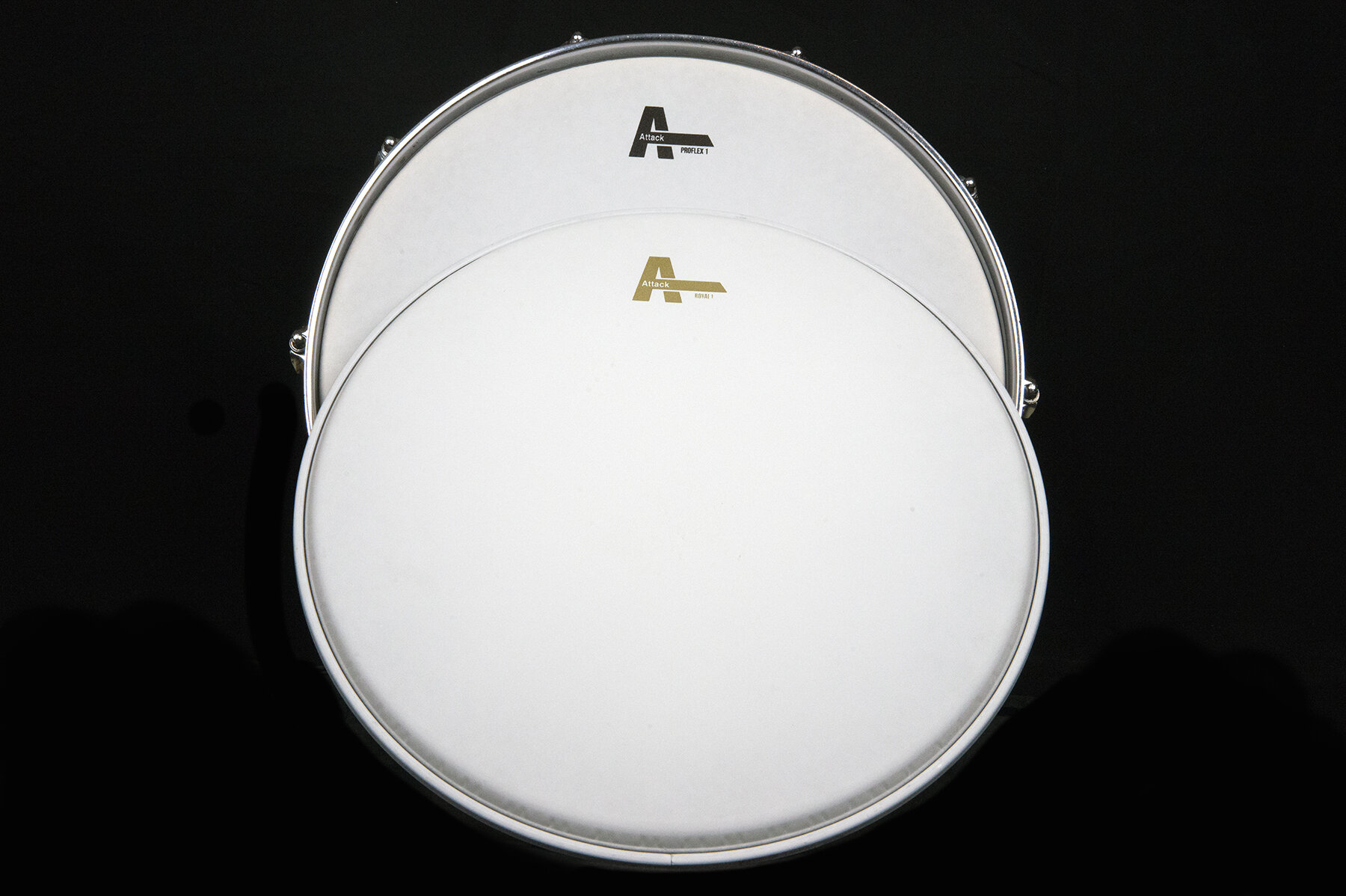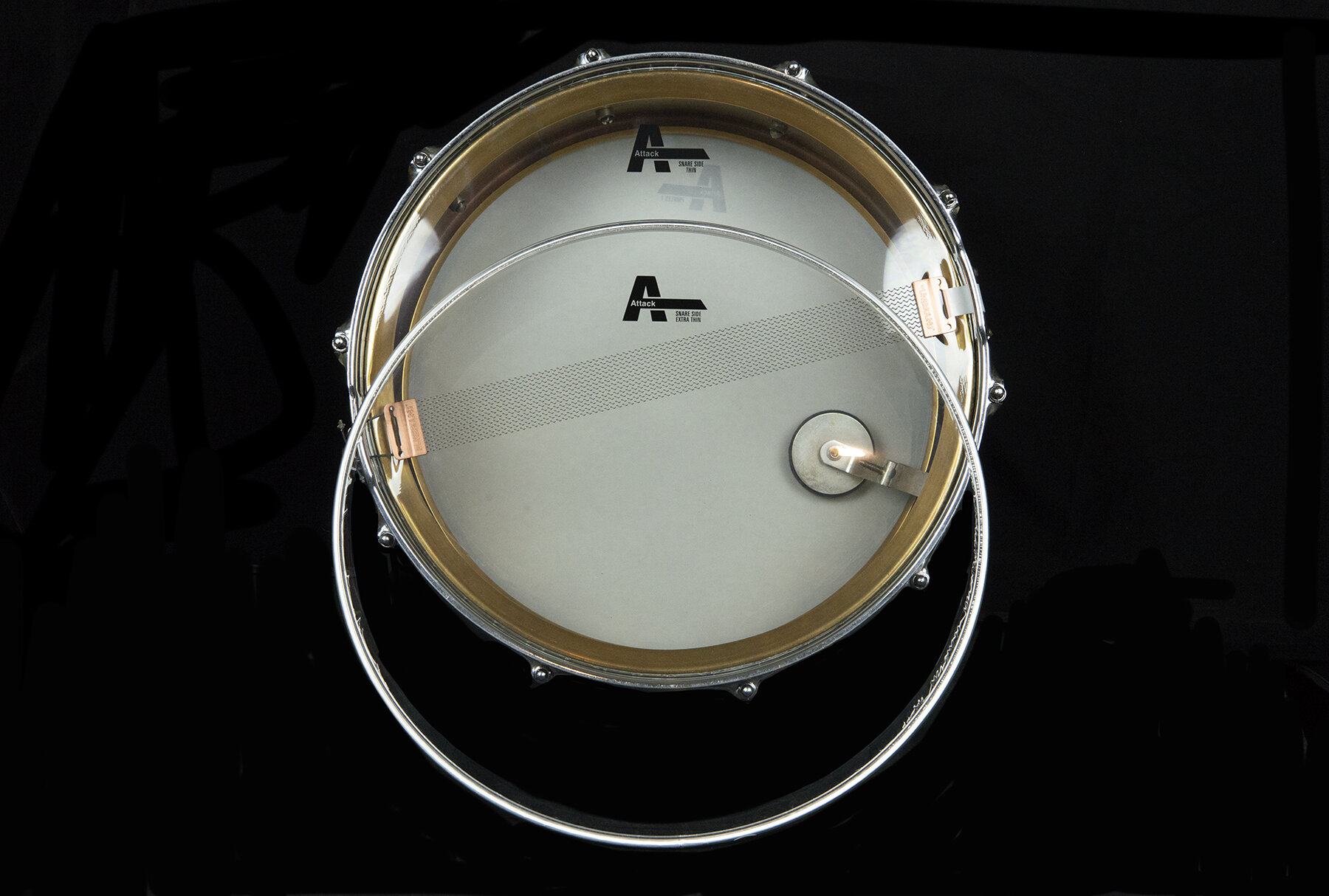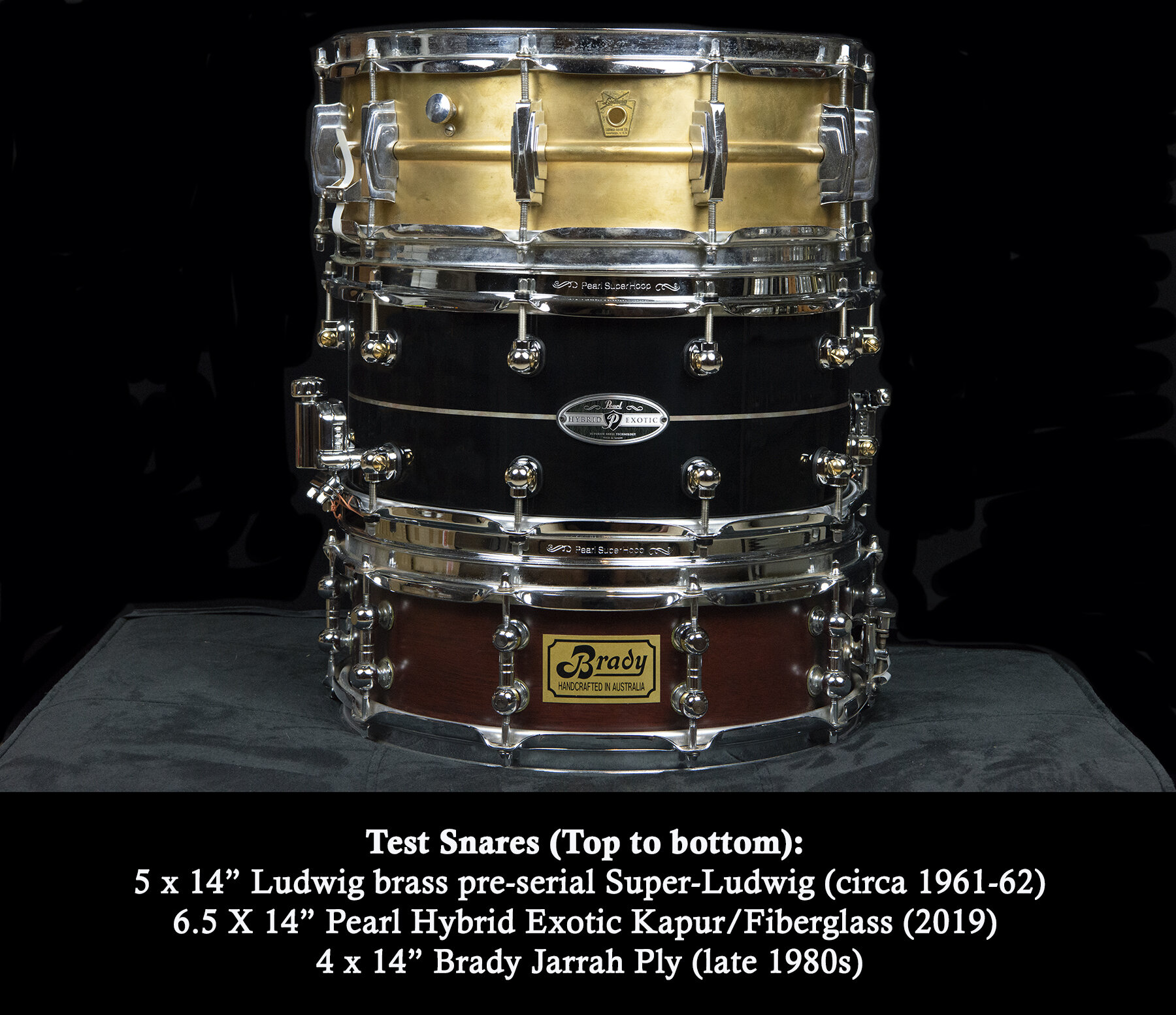Mark Tirabassi is a man who wears many hats. He owns/manages Hubbard Music, Cardinal Percussion, Wuhan Cymbals and Gongs, and notably, Attack Drumheads. He’s also a guy who loves drums, both contemporary and vintage. During one of our conversations about the latest and greatest in the drum world, Mark mentioned that I should check out his Attack Proflex1 and Royal1 drum heads. I enjoy trying out new gear, so it was easy for me to agree.
Fundamentally, drummers are always looking for new percussive sounds. Personally, I believe that swapping out heads and hoops should be common practice for all drummers. Just a modest change in the frequency response, attack, decay and/or feel could make all the difference in your playing and motivate you to play differently. In many cases, the unexpected result is most enticing.
It’s no secret that I am a big snare geek, having played several hundred over my lifetime. As such, Mark thought it altogether fitting to have me try out some snare heads. I received 4 Attack drum heads, all 14” snare, 2 top, 2 bottom: Proflex1 1-ply coated, Royal1 1-ply coated, snare side Thin, and snare side Extra Thin.
The Attack web site describes the Royal1 as having “subtle darker overtones than the Proflex1 combined with its long decay, our Royal series shines in the studio as well as on stage. If you are seeking that classic sound you will find it within the Royal Series. Both the clear and coated 10 mil versions are popular as batter and resonant side tom head. The Royal1 is a time-tested sound that is perfect for any type of genre. Rock, Pop, Blues, Jazz, Gospel, Funk, this head can do it all. The Royal1 series is made with the classic Dupont S film and Attacks Duracoat coating.”
According to Attack, the Proflex1 boasts a “bright, crisp attack with a long decay. Great for when you need a little extra projection. The clear, smooth white and black version seems to be the most common resonant side tom head. The Proflex 1 is the ‘jack of all trades’ for any type of genre. Rock, Pop, Blues, Jazz, Gospel, Funk, this head can do it all. The Proflex 1 series is made with Attacks popular 10 mil Dynaflex film and our Duracoat coating.”
CONSTRUCTION:
The Attack drum heads have a “glue-less steel locking collar” that is intended to resist the head pulling out from the collar and reduce any glue-related dampening. In addition, Attack claims that the extra mass of their hoop helps to lengthen the sustain and pinpoint the tonal focus. Attack drumheads are made of Mylar S film (Royal1) and Dynaflex polyester (Proflex1).
SOUND:
I currently use a modified 5 X 14” Ludwig pre-serial keystone badge Super-Ludwig (a.k.a. Supraphonic) as my primary gigging snare. It’s a brass Super-Sensitive (SS) with chrome-over-brass hoops that had the chrome stripped from the shell by a previous owner, who also removed the SS mechanism and replaced it with a standard p-83 throw-off. While not an ideal collector’s piece, it is an amazing “player” drum. It sounds great tuned high or low, making it an excellent test partner for these drum heads.
As always, my disclaimer is that these are subjective evaluations, and your opinion may differ. However, I hope the context of this review will give you adequate info to decide whether to explore these heads on your own.
The first drum head evaluated was the Royal1, with its distinctive gold logo. I tried it out first in combination with the thin resonant snare side head and then later with the Extra Thin resonant head. Unlike heads with glue at the hoop, I didn’t have to listen to any crackling sounds while I seated the head with my fist. My first impression was that it tuned up pretty easily and sounded really, really good without a lot of tweaking. There was a nice punch in the center with good edge to center sensitivity. I enjoyed the hefty attack and pleasant brass over-ring/overtones when played wide open. In my opinion, you can always take away or reduce overtones, but you can’t add them back. If you wanted even more center-weighted punch, Attack offers a reverse dot version of this head. I did add about ½ of a gel cling, and this adjustment muted the overtones but did not muffle the attack (no pun intended!). The combination with the thin resonant head really worked well for this drum.
I did also try the Royal1/Thin resonant combo on my 6.5 X 14” Pearl hybrid exotic Kapur/Fiberglass (thanks to Todd Sucherman for turning me on to this workhorse drum!). I obtained similar results but with far less overtones and little need for dampening. Again, this worked really nicely. Last, I tried the Royal1/Thin resonant combo on a 4 X 14” circa late 1980’s Brady Jarrah ply snare. The sound from the Brady was somewhat intermediate of the three snares, having more high-end overtones but less decay than the Ludwig brass but more than the Pearl hybrid. With the Brady, I did want to dampen the overtones and added ½ a gel cling. That gel really did the trick for this snare. In all cases, the Thin resonant was quite sensitive and the wires articulated well. There were no issues with fit or seating.
Last, I switched out the bottom head to the Attack Extra Thin resonant head. Overall, I didn’t hear a dramatic difference from the change-over, but the Extra Thin was subtly more sensitive than the Thin resonant head on snare drum rolls, especially with the tension cranked up a bit.
Next, I changed over to the ProFlex1 and did the same exercise, first with the Thin resonant head followed by the Extra Thin resonant head. As opposed to the gold Royal1 logo, the ProFlex1 was deep black. On all three snare drums (vintage Ludwig brass, Brady Jarrah, and modern Pearl hybrid), I found the ProFlex1 to be a bit more articulated, slightly shorter in decay, and with less higher frequency overtones. This head sounded especially good with the Extra Thin snare side head as it really eked out every bit of articulation from each drum. Note that the Proflex1 sounded great with Thin resonant head as well. The difference was slight (Thin vs. Extra Thin resonant), so clearly either were good choices for the ProFlex1.
With both Royal1 and ProFlex1 heads, the white coating was evenly distributed, not overly coarse and well-suited for brush playing. Sweeping brush strokes were smooth. This is often a good way to tell if there are any imperfections or inconsistency in the coating. No complaints here with either head.
In summary, I really liked these heads. I selected three snares from different generations (1960s, 1980s, 2019) with different shell compositions (brass, wood, hybrid) to examine the performance in a variety of situations. All the head combinations did very well in my hands.
I could see the Royal1 appealing to a very broad range of drummers in many genres. Perhaps the classical or jazz focused drummer might prefer the Extra Thin resonant head for its sensitivity but overall the Royal1 could work for many situations and many drums. I especially liked the pleasant overtones from my brass Ludwig and how I could dial it in with a combination of tension and muffling. I’d love to try the reverse dot version of this head and compare!
I also enjoyed the articulation and reduced overtones from the ProFlex1 and thought it did quite well at low tunings. Again, the ProFlex1 sounded great with either Thin or Extra Thin resonant heads so I found it a bit of toss-up. If you want a head fresh out of the box that doesn’t really need muffling, this is a worthy choice. I mentioned that there are some surprises in experimentation. In this case, the ProFlex1/Extra Thin resonant sounded amazing with the 4 x 14” Brady Jarrah ply. Perhaps the combination of shell material, depth and lack of dampening did the trick, but I did get impressive pop and sensitivity with this head combination (both high and medium tension).
I had a lot of fun playing with both the Royal1 and ProFlex1. I’m not sure if anything has changed, but they seemed so much better than many of the earlier Attack drum heads I had tried a few years ago. These heads were more versatile, open and dynamic than I expected. I can’t personally answer the question about durability but will continue to play them and see how they hold up. I should note that drummer, Rick Meadors, recently posted on drumforum.org about his experience with the Royal1 drum heads stating that, “Attack's coating is darn near indestructible in my experience… I've had that head on that snare for about 8 months now and have played it A LOT! Probably close to two dozen gigs plus a lot of playing at home during the past few months.” Given that I’m playing a variety of music with my current band, I will keep the Royal1 1/Thin resonant on my Ludwig brass Super-Ludwig and see how it goes.
Bottom line: these Attack drum heads are absolutely worth trying! I found some good prices on-line at zZsounds and Drum Center of Portsmouth. Many thanks to Mark Tirabassi for making these available for review. Please share your experiences with me, as I’m curious to hear what drums/tensions you are using and more about durability… I can be reached at fallendrummer@me.com
For more info on Attack Drum Heads: www.attackdrumheads.com
(Editor’s note: Not So Modern Drummer is an Attack Dealer and has some Attack models listed on DrumSellers.com. We also deal in all Cardinal products including Wuhan and Cardinal parts (formerly known as Cannon parts. I will also mention that the Royal head models were formerly branded as the Terry Bozzio model and use the same mylar plastic film that Remo uses. Contact george@notsomoderndrummer.com for info and prices)



